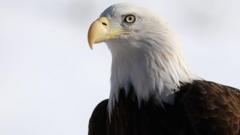The bald eagle has finally been declared the national bird of the United States, cementing its status after nearly 250 years of informal recognition.
Bald Eagle Officially Named National Bird of the U.S. After 250 Years

Bald Eagle Officially Named National Bird of the U.S. After 250 Years
President Joe Biden's recent signing recognizes the bald eagle's longstanding symbolic role in American history.
The bald eagle is now officially the national bird of the United States following President Joe Biden's signing of legislation on Christmas Eve. Although the bird has served as a national emblem since appearing on the Great Seal of the United States in 1782, it lacked formal designation until Congress approved the bill that reached the President's desk just last week.
“For nearly 250 years, we called the bald eagle the national bird when it wasn't,” stated Jack Davis, co-chair of the National Bird Initiative for the National Eagle Center. "But now the title is official, and no bird is more deserving." Many Americans are familiar with the eagle depicted on the seal, clutching a flag-emblazoned shield while holding an olive branch in one talon and arrows in the other.
Interestingly, not everyone has supported the bald eagle as a national symbol. Founding Father Benjamin Franklin famously criticized the choice, branding the eagle a "bird of bad moral character." Despite this dissent, the bald eagle has long been viewed by many as a representation of strength, courage, freedom, and immortality—a sentiment shared by the U.S. Department of Veteran Affairs. Notably, the bald eagle is unique to North America, making it particularly significant.
The legislation was primarily advocated by lawmakers from Minnesota, a state known for having one of the largest populations of bald eagles in the nation, as highlighted by Senator Amy Klobuchar. Additionally, the bald eagle is protected under the National Emblem Act of 1940, which prohibits selling or hunting the species. Following a period of near extinction, the bald eagle population has seen a resurgence since 2009.
The bald eagle bill was among 50 pieces of legislation signed by Biden on the holiday, including a significant federal anti-hazing law aimed at addressing violence and fatalities on college campuses.
“For nearly 250 years, we called the bald eagle the national bird when it wasn't,” stated Jack Davis, co-chair of the National Bird Initiative for the National Eagle Center. "But now the title is official, and no bird is more deserving." Many Americans are familiar with the eagle depicted on the seal, clutching a flag-emblazoned shield while holding an olive branch in one talon and arrows in the other.
Interestingly, not everyone has supported the bald eagle as a national symbol. Founding Father Benjamin Franklin famously criticized the choice, branding the eagle a "bird of bad moral character." Despite this dissent, the bald eagle has long been viewed by many as a representation of strength, courage, freedom, and immortality—a sentiment shared by the U.S. Department of Veteran Affairs. Notably, the bald eagle is unique to North America, making it particularly significant.
The legislation was primarily advocated by lawmakers from Minnesota, a state known for having one of the largest populations of bald eagles in the nation, as highlighted by Senator Amy Klobuchar. Additionally, the bald eagle is protected under the National Emblem Act of 1940, which prohibits selling or hunting the species. Following a period of near extinction, the bald eagle population has seen a resurgence since 2009.
The bald eagle bill was among 50 pieces of legislation signed by Biden on the holiday, including a significant federal anti-hazing law aimed at addressing violence and fatalities on college campuses.


















